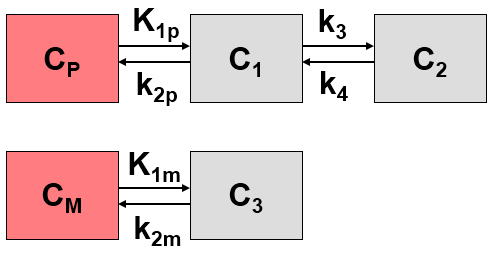If a labeled metabolite of the tracer enters tissue, the additional signal has to be accounted for in the model. The current model introduced by Fujita et al. [1] includes a second input curve CM(t) of a metabolite entering tissue and undergoing non-specific binding.

C1 represents the non-displaceable compartment of the authentic ligand, C2 the specific binding of interest, and C3 metabolized ligand in tissue.
Differential Equation of the Mass Balance

with the input curves of authentic ligand and metabolite, Cp(t) and CM(t), respectively. The input curve loading menu shows two corresponding entries as soon as the model is selected.
Operational Model Curve

with the concentration CB(t) of tracer in whole blood, and the blood volume fraction vB.
Parameter Fitting
The model includes the 7 fitable parameters vB, K1p, k2p, k3, k4, K1m, k2m. Due to the high number of parameters reliable fitting is difficult. There are two other model variants which support coupled fitting by using distribution volumes as fit parameters.
Models with Alternative Fit Parameters
There are two alternative models available which have the same structure but use some parameter ratios as fit parameters. The advantage is that these ratios might be candidates as common parameters among regions in a coupled fit, or might be fixed at known values.
Reference
1.Fujita M, Seibyl JP, Verhoeff NP, Ichise M, Baldwin RM, Zoghbi SS, Burger C, Staley JK, Rajeevan N, Charney DS et al: Kinetic and equilibrium analyses of [(123)I]epidepride binding to striatal and extrastriatal dopamine D(2) receptors. Synapse 1999, 34(4):290-304.